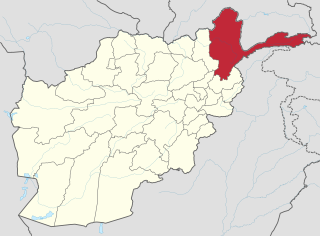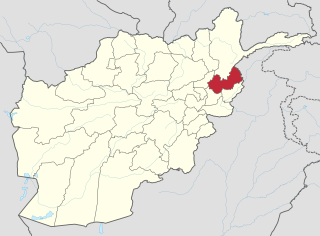Related Research Articles

Badakhshan is a historical region comprising parts of modern-day north-eastern Afghanistan, eastern Tajikistan, and Taxkorgan Tajik Autonomous County in China. Badakhshan Province is one of the 34 provinces of Afghanistan. Much of historic Badakhshan lies within Tajikistan's Gorno-Badakhshan Autonomous Region in the southeastern part of the country. The music of Badakhshan is an important part of the region's cultural heritage.

Badakhshan Province is one of the 34 provinces of Afghanistan, located in the northeastern part of the country. It is bordered by Tajikistan's Gorno-Badakhshan in the north and the Pakistani regions of Lower and Upper Chitral and Gilgit-Baltistan in the southeast. It also has a 91-kilometer (57-mile) border with China in the east.

The Blons avalanches took place in Austria in January 1954. They occurred in the federal state of Vorarlberg, where they had a big impact on the Great Walser Valley region and specifically, the village of Blons. The avalanches occurred over a two-day period beginning from 11 January 1954 and resulted in the death of 125 people, 57 of whom were killed specifically in Blons. Two big avalanches struck Blons within 9 hours, the second of which buried rescue workers who were attempting to save civilians from the first avalanche. The avalanches caused much destruction to the Blons village, damaging one third of housing infrastructure and killing one third of the population. The Blons avalanches are considered to be one of the worst mass burials in Austrian history, resulting in one of the highest number of fatalities due to an avalanche.

Shekay or Shikai Persian: شهرستان شِکی is one of the 28 districts of Badakhshan province in northeastern Afghanistan. It was created in 2005 from part of Darwaz District and is home to approximately 26,000 residents. This district borders Nusay and Kuf Ab districts in Badakhshan and also Darvoz District in the Gorno-Badakhshan Autonomous Region of Tajikistan.

An earthquake occurred at 08:50:39 Pakistan Standard Time on 8 October 2005 in Azad Jammu and Kashmir, a territory under Pakistan. It was centred near the city of Muzaffarabad, and also affected nearby Balakot in Khyber Pakhtunkhwa and some areas of Jammu and Kashmir, India. It registered a moment magnitude of 7.6 and had a maximum Mercalli intensity of XI (Extreme). The earthquake was also felt in Afghanistan, Tajikistan, India and the Xinjiang region. The severity of the damage caused by the earthquake is attributed to severe upthrust. Over 86,000 people died, a similar number were injured, and millions were displaced. It is considered the deadliest earthquake in South Asia, surpassing the 1935 Quetta earthquake.
The February 1998 Afghanistan earthquake occurred at 19:03 local time near the Afghanistan-Tajikistan border. The strike-slip shock had a moment magnitude of 5.9 and a maximum Mercalli intensity of VII. With several thousand dead and hundreds injured, the event's effects were considered extreme by the National Geophysical Data Center. It was felt at Tashkent and Dushanbe, and aftershocks continued for the next seven days.
An earthquake occurred in northern Afghanistan on 30 May 1998, at 06:22 UTC in Takhar Province, with a moment magnitude of 6.5 and a maximum modified Mercalli intensity of VII. At the time, the Afghan Civil War was underway; the affected area was controlled by the United Islamic Front for the Salvation of Afghanistan.
The Qayen earthquake, also known as the Ardekul or Qaen earthquake, struck northern Iran's Khorasan Province in the vicinity of Qaen on May 10, 1997 at 07:57 UTC. The largest in the area since 1990, the earthquake registered 7.3 on the moment magnitude scale and was centered approximately 270 kilometers (170 mi) south of Mashhad on the village of Ardekul. The third earthquake that year to cause severe damage, it devastated the Birjand–Qayen region, killing 1,567 and injuring more than 2,300. The earthquake—which left 50,000 homeless and damaged or destroyed over 15,000 homes—was described as the deadliest of 1997 by the United States Geological Survey. Some 155 aftershocks caused further destruction and drove away survivors. The earthquake was later discovered to have been caused by a rupture along a fault that runs underneath the Iran–Afghanistan border.

The 2010 Salang avalanches consisted of a series of at least 36 avalanches that struck the southern approach to the Salang Tunnel, north of Kabul. They were caused by a freak storm in the Hindu Kush mountains.

The global weather activity of 2010 includes major meteorological events in the Earth's atmosphere during the year, including winter storms, hailstorms, out of season monsoon rain storms, extratropical cyclones, gales, microbursts, flooding, rainstorms, tropical cyclones, and other severe weather events.

On 7 April 2012, an avalanche hit a Pakistan Army base in Gayari Sector, near the Siachen Glacier region, trapping 140 soldiers and civilian contractors under deep snow. The incident occurred at an altitude of about 4,000 meters and 300 km northeast of Skardu. It was the worst avalanche that the Pakistani military has experienced in the area.

On 2 May 2014, a pair of mudslides occurred in Argo District, Badakhshan Province, Afghanistan. The death toll is uncertain, the number of deaths the number of deaths is believed to be at least 350 and no more than 2,700. Around 300 houses were buried and over 14,000 were affected. Rescuers responding to the initial mudslide were struck by a second mudslide, which further hampered rescue efforts.

The 2015 Afghanistan avalanches happened in late February 2015 in northeastern Afghanistan. The avalanches affected four provinces, including Panjshir province and Parwan province and may have killed as many as 308 people.

On 23 April 2015, a landslide occurred in the Khawahan district of Badakhshan Province in Afghanistan. Around 100 houses were destroyed and 52 people were killed by the landslide. A second landslide occurred on 26 April, displacing 120 families.

The 2017 Afghanistan avalanches were a series of avalanches that struck villages on the Afghanistan–Pakistan border between February 4 and 6, 2017. More than 100 people reportedly died in the disaster, including more than 50 people in Nuristan Province and at least 19 people in the neighbouring Badakhshan area of Pakistan's Chitral region. Dozens of homes and fhams were destroyed, and hundreds of animals died due to the avalanches. In Pakistan, the affected areas included regions of Balochistan, Mastung, Kalat and Kharan.
In February 2020, two avalanches occurred near Bahçesaray in Turkey's eastern Van Province. The first, on 4 February, buried two vehicles, leading to a rescue operation involving around 350 people. The second, on 5 February, occurred while this operation was ongoing. At least 41 people were killed in the two avalanches, with 84 others being injured, six seriously.
The 1991 Hindu Kush earthquake occurred northeast of Kabul, Afghanistan on February 1, 1991. It was an intermediate-depth earthquake with a hypocenter 142.4 km beneath the Hindu Kush mountains. It measured 6.9 on the moment magnitude scale, and affected neighbouring Pakistan and the USSR. At least 848 people were killed in both countries and damage was estimated at $26 million USD.

A 4.0-kilometre (2.5 mi) deep earthquake measuring magnitude (Mw ) 6.2 struck southeastern Afghanistan on 22 June 2022 at 01:24:36 AFT. The earthquake had a maximum Modified Mercalli intensity of IX (Violent). There were 1,052–1,163 deaths and 1,627–2,976 injured in Afghanistan and Pakistan. The worst affected provinces in Afghanistan were Paktika, Paktia, Khost and Nangarhar. Casualties and damage also occurred in Pakistan's Khyber Pakhtunkhwa. At least 10,000 homes collapsed or were severely damaged. The earthquake's shallow hypocenter, proximity to populated areas and low building quality contributed to its destructive effects. Shaking was felt over 500 km (310 mi) away by at least 119 million people, including Pakistan's Punjab and parts of India and Iran.
Madaklasht is a valley located in Lower Chitral district, Khyber Pakhtunkhwa, Pakistan. The valley is predominantly inhabited by the Tajik people who speak Madaklashti, a dialect of Persian.

Four large earthquakes measuring Mww 6.3 each and their aftershocks affected Herat Province in western Afghanistan in early October 2023. The first two earthquakes occurred on 7 October at 11:11 AFT and 11:42 AFT near the city of Herat, followed by many aftershocks. On 11 and 15 October, two other magnitude 6.3 earthquakes struck the same area. Thrust faulting was associated with these earthquakes. The World Health Organization estimated 1,482 fatalities, 2,100 injuries, 43,400 people affected and 114,000 people requiring humanitarian aid. The 11, 15 and 28 October earthquakes caused a combined seven deaths and 344 injuries.
References
- 1 2 3 4 Shah, Amir (March 7, 2012). "47 dead in Afghanistan avalanche". Google. Associated Press. Retrieved March 8, 2012.[ dead link ]
- 1 2 3 4 5 6 7 8 Alissa J. Rubin (March 6, 2012). "Avalanche and Attacks Add to Woes of Afghans". New York Times. Retrieved March 8, 2012.
- 1 2 3 4 "Search for survivors after Afghan avalanches kill 42". Google. Agence France-Presse. March 7, 2012. Archived from the original on January 24, 2013. Retrieved March 8, 2012.
- 1 2 3 4 5 6 7 8 9 10 11 12 Bowley, Graham (March 7, 2012). "Avalanche Exposes Afghans' Vulnerability to Vagaries of Climate and of Aid". New York Times. Retrieved March 7, 2012.
- 1 2 3 4 5 6 Amir Shah (March 8, 2012). "Avalanche buries Afghanistan village". Sky News. AP. Retrieved March 8, 2012.
- 1 2 "Avalanche kills 37 in Afghan village". The News. AFP. March 7, 2012. Retrieved March 8, 2012.
